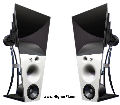 How to separate "wet" and "dry" part of some effect? How to separate "wet" and "dry" part of some effect? |
wrm
orchestral/idm/deep/liquid/experi/mental
  

Registration Date: 13-09-2006
Posts: 465
Helpfulness rating:
 |
|
Hey guys, did someone try to separate, lets say when applying reverb to some sample, the dry (the sample itself) and the wet (the reverbed effect without the sample) part of the sounds? Lets say I wanna have 2 channels on my mixer - one with the original sample and second with just the reverbed sound of the sample. Any tips?
__
___ Visit MYspace ___
|
|
|
18-06-2011 21:41 |

|
|
Gregg 
Wicked Producer
  

Registration Date: 16-05-2007
Posts: 417
Helpfulness rating:
 |
|
Simple. Copy the sample. Apply the desired amount of reverb to your sample, the copy stays dry but you reverse its polarity. When both samples hit at the same time now all that should be left is the wet signal.
Add another copy, unprocessed and with unchanged polarity, and you have the original sample with the reverb tail. There should be no difference in sound if you mute both copies or hit all the samples at the same time.
|
|
|
19-06-2011 14:00 |

|
|
wrm
orchestral/idm/deep/liquid/experi/mental
  

Registration Date: 13-09-2006
Posts: 465
Helpfulness rating:
 |
|
Cheers for tip Gregg, but i realized how to do that just couple minutes later I posted this thread. Its actually even simpler. I routed the original sample to mixer track 1. Then I sent the signal from that track to some other track, lets say track 2. Important thing is to send signal from track 1 to track 2 and to master aswell. Then on track 2 i applied the reverb vst but set the output of it to be only the wet signal. Thats it.
__
___ Visit MYspace ___
|
|
|
20-06-2011 01:48 |

|
|
BattleDrone 
2161... the future.
    

Registration Date: 30-12-2005
Posts: 6,413
Helpfulness rating:
 |
|
Route the sound into 2 mixer channels. The first one is dry and stays dry (duh?).
The second get's reverb and you turn the "wet" knob to the desired amount and turn the "dry" knob to zero. There you go.
EDIT: I see you figured it out yourself 
__
 Check my soundcloud (exclusive tracks on there) Check my soundcloud (exclusive tracks on there)
|
|
|
20-06-2011 09:08 |

|
|
gripz 
Cool Producer
 

Registration Date: 16-11-2002
Posts: 138
Helpfulness rating:
 |
|
This is indeed how it's done.
However i believe the "real" way 2 do it is routing the dry mixer channel 2 a send channel.
A send channel is basicly the same as any other mix channel altho u can't send it 2 other mixer channels afterwards, just 2 the master.
I don't use em alot myself except for example when i want multiple hi parts of my beat 2 have the same reverb or delay or something like that. Beats assigning 2 mixer tracks and an effect for every sample.
|
|
|
04-07-2011 14:37 |
|
|
|
